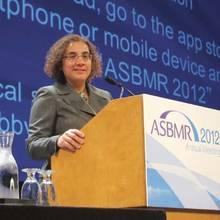MINNEAPOLIS – The risk of hip fracture among elderly patients spikes shortly after starting antihypertensive medications, judging from the findings of a large self-controlled, case series analysis.
Overall, elderly community-dwelling patients had a 43% increased risk of hip fracture within 45 days of initiating an antihypertensive therapy (incidence rate ratio, 1.41; 95% confidence interval, 1.19-1.72).
The risk was significantly higher only for two of the five classes of commonly used antihypertensive drugs: ACE inhibitors and beta-blockers.
The risk of early fracture rose by 53% for patients started on an ACE inhibitor (IRR, 1.53; 95% CI, 1.12-2.10) and by 58% for those on beta-blockers (IRR, 1.58; 95% CI, 1.01-2.48), Dr. Debra Butt reported at the annual meeting of the American Society of Bone and Mineral Research.
This is the first large population-based study to report such an association, and the evidence is conflicting regarding the association between antihypertensives and fracture risk. The majority of studies evaluate long exposure periods, where the underlying mechanism is thought to be related to bone mass.
On the other hand, there are studies of immediate increased risk of falls in the elderly started on antihypertensive drugs, where orthostatic hypotension is thought to be the underlying mechanism. One recently updated analysis reported that the effect on falls in the elderly was strongest in the first 3 weeks of a thiazide diuretic prescription (IRR, 2.80), after taking into account confounding factors (Pharmacoepidemiol. Drug Saf. 2011;20:879-84).
The current analysis used six health care administrative databases to identify 301,591 newly treated hypertensive patients at least 66 years of age living in Ontario and link them with hip fractures occurring from April 1, 2000, to March 31, 2009. The risk period was the first 45 days following initiation of monotherapy antihypertensive therapy, with control periods before and after treatment in a 450-day observation period.
The study excluded long-term care residents and patients with conditions other than hypertension for which an antihypertensive drug may have been prescribed such as diabetes, myocardial infarction, heart failure, angina, cardiomyopathy and transient ischemic attack.
At baseline, only 3% of patients had had a fall in the past year requiring hospital care and 6% had a history of past hip fracture. The majority of patients were female (81%) and the median age was 80.8 years.
Antihypertensive drugs included thiazide diuretics (23%), ACE inhibitors (30%), angiotensin receptor blockers (4%), calcium channel blockers (17%) and beta blockers (26%).
During the observation period, 1,463 hip fractures were identified, according to Dr. Butt of the department of family and community medicine, University of Toronto.
A sensitivity analysis that excluded use of other potential fall-causing drugs and psychotropic drugs that can trigger falls, confirmed the initial association between antihypertensive drug initiation and early hip fracture with a nearly identical incidence ratio of 1.42.
"Based on this finding, caution is advised when initiating antihypertensive drugs in the elderly," she said.
During a discussion of the study, however, concerns were raised about what to advise patients without knowing the absolute risk of falling and the risk of hip fracture while on antihypertensive medications vs. the benefits of treating hypertension.
One audience member said the study alerts clinicians to the risk but that it’s hard to draw any practical, clinical recommendations without more information such as when the falls occurred, whether the patient was standing or sitting down at the time of the fracture, or the magnitude of the hypertension decrease from baseline.
"In order to develop clinical recommendations, you have to start by demonstrating an association and that’s what our study does," Dr. Butt responded. "It’s a start, in an area where we have few studies that exist."
The government of Ontario funded the study. Dr. Butt reported no relevant conflicts of interest.


